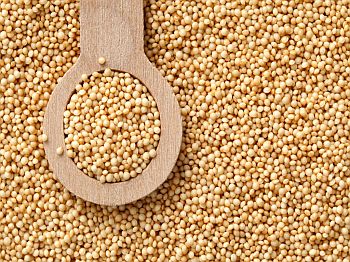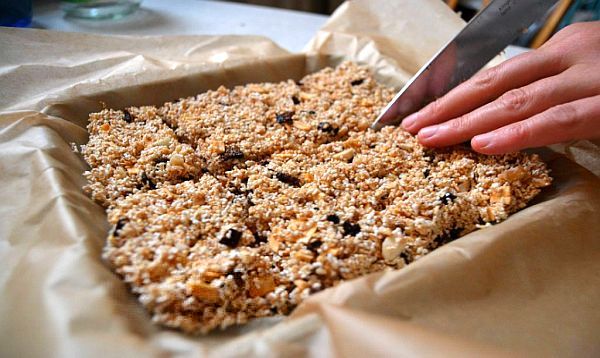Amaranth has been described as one of the world's super foods, and is ingrained in Mexican history, rich in culture and nutritional value.
Although amaranth tastes like a grain and has a nutty, almost malty flavor, it is actually a seed. Likened to quinoa, amaranth is high in protein and amino acids and is being re-introduced as a staple food to Oaxaca, Mexico, to help tackle malnutrition in the region.
The most commonly found use of amaranth seeds are when they have been "popped" - after which they sell for almost four times the price. In this form it's eaten as a cereal, or combined with honey, (sometimes chocolate,) to make bars known as alegria - which means "happiness" in Spanish.
I also tried a delicious cake made with the seeds while in Oaxaca this summer, celebrating the second anniversary of a group of amaranth producers called Red Amarantho. The powdered seed can be mixed into flour and then made into everything from gluten free flat breads to sponge cake. Or for an alternative form of porridge, the un-popped seeds can be cooked in water for 15 minutes - either on their own or together with your usual oats.
A Limited Diet Is Leading to Widespread Malnutrition
Oaxaca is a large state in Southwest Mexico, stretching from a mountainous central region, down to the Pacific coast. The population is mostly indigenous, and according to the government agency Conapo, the third poorest in Mexico. The economy is based on agriculture, however, due to the mountainous terrain this is limited and the production of food staples such as corn and beans cannot meet demand.
 |
| Some amaranth is cultivated as leaf vegetables, cereals, and ornamental plants. Amaranth is a natural source of folic acid. |
Oaxaca's rural communities survive on a very limited diet. This lack of diversity leads to deficiencies of the amino acids and nutrients needed for growth, and can cause very serious health problems.
Children and pregnant women are at particular risk of malnutrition which can be severe and irreversible, perpetuating a cycle of poverty. Despite the health services existing in Oaxaca, they struggle to meet the needs of the state. Over 40 percent of pregnant women do not receive pre-natal care from people who are medically qualified.
A Natural Source of Folic Acid
Southern Mexico also has one of the highest rates in the world of neural tube birth defects. Risks of developing these are reduced by up to 75 percent if the mother has enough folic acid or folate in her diet, before and during pregnancy. Amaranth is high in folic acid (lysine,) a B-vitamin essential during pregnancy. A deficiency in this vitamin can cause neurological disorders such as spina-bifida. Folic acid can also be found in liver, leafy green vegetables, broccoli, and peas - although with these foods, much of it is lost in the cooking process.
In the UK, where up to three babies a week are born with spina-bifida, women are often given supplements of folic acid. This year the British government has been put under pressure to add folic acid to flour to reduce the occurrence of neurological defects.
Amaranth is a natural way to boost the amount of folic acid in the diet. The seeds can be used as a cereal, or crushed and mixed with flour. Although it hasn't yet reached the reputation of quinoa in the health-food market, amaranth is higher in both protein and in folic acid.
The Ancient Food of Aztecs and Mayans
The charity Puente has been working to re-introduce amaranth for the past ten years. It was founded in 2003 by Kate Seely and Katherine Lorenz. They came to Oaxaca as volunteers, and became fascinated by the potential of the grain; for its economic and nutritional benefits, as well as its cultural significance to the area.
Called huautli in Nahuatl, the Aztec language, there is evidence that amaranth has been harvested for thousands of years, and was eaten by the Mayans and Aztecs. One form was as "energy balls," made by combining crushed seeds and agave honey, or it could be mixed with human blood for ritual offerings to the gods. It was also used to celebrate the birth of new children, and a paste was made to make symbolic objects for the baby.
 |
| Amaranth seeds have a nutty, almost malty flavor. |
Puente runs two main projects side by side, "Healthy Families" and "Eco Amaranth," aiming to revitalise the understanding and appreciation of the plant as part of the Oaxacan agricultural system.
Healthy Families focuses on the education of mothers and improving malnourishment among young children. This program works with women from vulnerable populations to address some of the root causes of malnutrition in their communities. Eco Amaranth focuses on training local subsistence farmers to produce the grain. The aim is that they will be able to generate income and provide a more varied diet for their families.
"A Noble Plant"
Puente work with a group of local amaranth producers called Red Amarantho, who make the traditional alegria bars and other products.
Last August they celebrated their second anniversary at the Oaxacan town of Etla. It was an opportunity for growers to meet and share their products with the local community. There were talks from members of the group, and Puente volunteers were there with leaflets and coloring books about amaranth, for children at the event.
I also went out to see some of the growers in the area. One of the growers, Alba Garcia, was planting for her second harvest of the amaranth. She is a member of Red Amarantho and is supported by Puente.
An ambitious farmer, Alba grows maize and bean plants, as well as award winning hibiscus flowers. She is excited to explore the varied uses of amaranth, even making it into a jelly! Her reasons for introducing the plant are not mainly financial, but rather because she considers it a "noble plant." Other growers I met make similar claims.
Don Maximiliano, a 94 year old farmer who lives near Etla, is growing amaranth for the first time. He is willing to overcome early practical difficulties, and ingrained prejudices against the plant, to re-introduce this valuable crop to the area.
In 1977 an article in Science magazine described amaranth as "the crop of the future." In 2014, as it is being revitalized as an accessible and acceptable food source in Mexico, it is also becoming appreciated on the global health-food scene.
 |
| Alegria cereal bars for Dia de los Muertos. |
Recipe for Alegria Bars
To make the traditional alegria cereal bars you need:
• 6 tablespoons of honey
• 1 tablespoon of butter
• 1 cup of washed and dried amaranth seed
• Up to 1 cup of "extras" (For example, sunflower or pumpkin seeds, dried fruit, and flaked coconut.)
1. Pop the amaranth in a skillet over medium heat (like popcorn.)
2. Mix the honey and butter, then boil the mixture over a medium heat stirring constantly with a wooden spoon for 5-8 minutes.
3. When the mixture is completely homogenous, hot, and lightly browned, add the amaranth.
4. Add your extras and mix everything together thoroughly.
5. Spread into a tray and leave to cool.
6. Cut into any shapes you like.
Original Story


